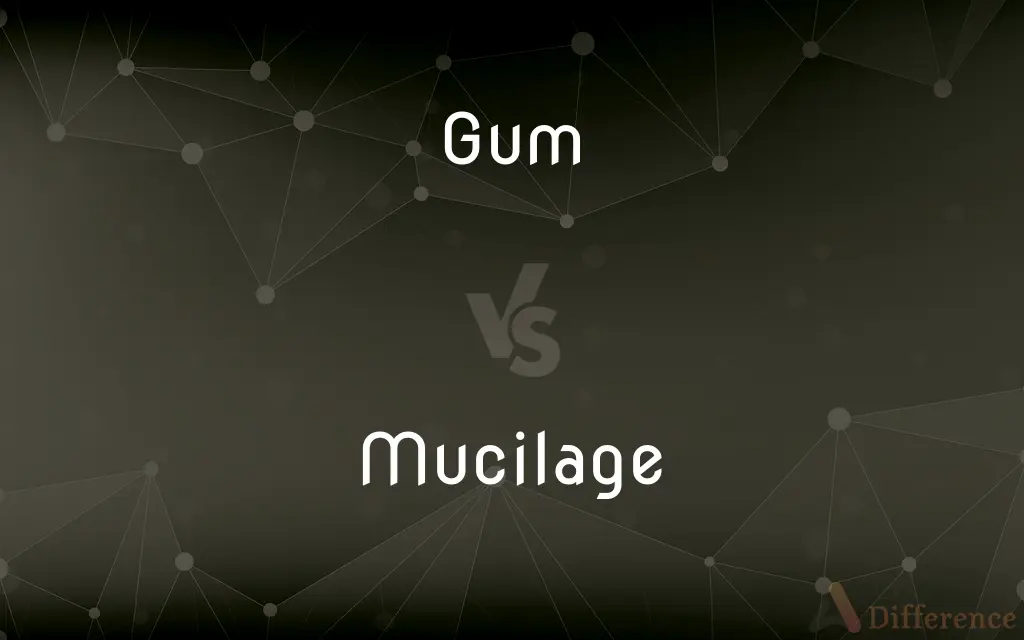Gum vs. Mucilage — What's the Difference?
By Tayyaba Rehman — Updated on October 16, 2023
Gum refers to the resinous substance from trees used in products or to chewable treats. Mucilage is a viscous, soluble fiber found in plants and used for storage or protection.

Difference Between Gum and Mucilage
Table of Contents
ADVERTISEMENT
Key Differences
Gum is a versatile term in English. Most commonly, it can refer to a substance derived from trees, which has a range of commercial applications, from food to products like adhesives. Meanwhile, mucilage is specific to the world of botany and describes a sticky substance produced by nearly all plants and some microorganisms.
In everyday use, when people think of gum, they might envision the chewable treat that's enjoyed worldwide. This is quite different from mucilage, which isn't typically discussed in daily conversation, but is more of a concern to botanists or those in the food and drug industry due to its stabilizing and thickening properties.
Gum also has historical significance. For instance, gum arabic, derived from the sap of the acacia tree, has been used for centuries in food, medicine, and art. In contrast, mucilage, which is often extracted from seaweed or specific plants, has been utilized for its emulsifying properties in various industries.
One thing gum and mucilage have in common is their application in the food industry. While gum might be used as a direct ingredient in certain foods, mucilage is found in things like flax seeds and okra and is known for its potential health benefits when consumed.
Comparison Chart
Source
Trees and plants (resinous substance)
Nearly all plants (viscous fiber)
ADVERTISEMENT
Common Usage
Chewable treat, adhesives, art
Botany, food industry, medicine
Properties
Resinous, can be tacky
Sticky, gelatinous, soluble
Applications
Food, art, medicine
Stabilizing, thickening, emulsifying
Associated Terms
Gum arabic, gum tree
Plant mucilage, seaweed mucilage
Compare with Definitions
Gum
To smear or cover with gum.
He gummed the paper together.
Mucilage
An adhesive solution.
He used mucilage to paste the labels.
Gum
Any of various viscous substances that are exuded by certain plants and trees and dry into water-soluble, noncrystalline, brittle solids.
Mucilage
A thick, gluey substance produced by plants and microorganisms.
Okra releases mucilage when cooked, giving a slimy texture.
Gum
A similar plant exudate, such as a resin.
Mucilage
A viscous, soluble fiber in plants used for storage/protection.
The mucilage of the aloe plant has soothing properties.
Gum
Any of various adhesives made from such exudates or other sticky substance.
Mucilage
The sticky substance on the adhesive side of a stamp.
He licked the mucilage on the stamp before sticking it.
Gum
A substance resembling the viscous substance exuded by certain plants, as in stickiness.
Mucilage
A watery gel formed with water and a soluble substance.
The flax seeds formed a mucilage after soaking.
Gum
Any of various trees, especially of the genera Eucalyptus and Liquidambar, that are sources of gum. Also called gum tree.
Mucilage
Mucilage is a thick, gluey substance produced by nearly all plants and some microorganisms. These microorganisms include protists which use it for their locomotion.
Gum
The wood of such a tree; gumwood.
Mucilage
A viscous secretion or bodily fluid.
Gum
Chewing gum.
Mucilage
Any of various viscous, water-soluble polysaccharides produced by certain plants, algae, and microorganisms.
Gum
The firm connective tissue covered by mucous membrane that envelops the alveolar arches of the jaw and surrounds the bases of the teeth. Also called gingiva.
Mucilage
A sticky substance used as an adhesive.
Gum
To cover, smear, seal, fill, or fix in place with gum.
Mucilage
A thick gluey substance (gum) produced by many plants and some microorganisms.
Gum
To exude or form gum.
Mucilage
A gummy or gelatinous substance produced in certain plants by the action of water on the cell wall, as in the seeds of quinces, of flax, etc.
Gum
To become sticky or clogged.
Mucilage
An aqueous solution of gum, or of substances allied to it; a glue; a liquid adhesive; as, medicinal mucilage; mucilage for fastening envelopes.
Gum
To chew (food) with toothless gums.
Mucilage
A gelatinous substance secreted by plants
Gum
The flesh around the teeth.
Mucilage
Cement consisting of a sticky substance that is used as an adhesive
Gum
Any of various viscous or sticky substances that are exuded by certain plants.
Gum
Any viscous or sticky substance resembling those that are exuded by certain plants.
Gum
Chewing gum.
Gum
(countable) A single piece of chewing gum.
Do you have a gum to spare?
Gum
A gummi candy.
Gum
A hive made of a section of a hollow gum tree; hence, any roughly made hive.
Gum
A vessel or bin made from a hollow log.
Gum
A rubber overshoe.
Gum
A gum tree.
Gum
To chew, especially of a toothless person or animal.
Gum
(transitive) To deepen and enlarge the spaces between the teeth of (a worn saw), as with a gummer.
Gum
To apply an adhesive or gum to; to make sticky by applying a sticky substance to.
Gum
To stiffen with glue or gum.
Gum
To inelegantly attach into a sequence.
Gum
To impair the functioning of a thing or process.
That cheap oil will gum up the engine valves.
The new editor can gum up your article with too many commas.
Gum
The dense tissues which invest the teeth, and cover the adjacent parts of the jaws.
Gum
A vegetable secretion of many trees or plants that hardens when it exudes, but is soluble in water; as, gum arabic; gum tragacanth; the gum of the cherry tree. Also, with less propriety, exudations that are not soluble in water; as, gum copal and gum sandarac, which are really resins.
Gum
See Gum tree, below.
Gum
A hive made of a section of a hollow gum tree; hence, any roughly made hive; also, a vessel or bin made of a hollow log.
Gum
A rubber overshoe.
Gum
To deepen and enlarge the spaces between the teeth of (a worn saw). See Gummer.
Gum
To smear with gum; to close with gum; to unite or stiffen by gum or a gumlike substance; to make sticky with a gumlike substance.
He frets like a gummed velvet.
Gum
To chew with the gums, rather than with the teeth.
Gum
To exude or form gum; to become gummy.
Gum
A preparation (usually made of sweetened chicle) for chewing
Gum
The tissue (covered by mucous membrane) of the jaws that surrounds the bases of the teeth
Gum
Any of various substances (soluble in water) that exude from certain plants; they are gelatinous when moist but harden on drying
Gum
Cement consisting of a sticky substance that is used as an adhesive
Gum
Wood or lumber from any of various gum trees especially the sweet gum
Gum
Any of various trees of the genera Eucalyptus or Liquidambar or Nyssa that are sources of gum
Gum
Grind with the gums; chew without teeth and with great difficulty;
The old man had no teeth left and mumbled his food
Gum
Exude or form gum;
These trees gum in the Spring
Gum
A resinous substance from trees used in products.
The adhesive contains natural gum.
Gum
A chewable substance made from synthetic or natural resins.
I love the mint flavor of this gum.
Gum
The firm area around the base of a tooth.
He has inflamed gums.
Gum
To become clogged or choked up.
The machine will gum up if not cleaned.
Common Curiosities
Can gum be natural?
Yes, like gum arabic from acacia trees.
What is gum commonly used for?
Chewing and as a base for various products.
Where is mucilage typically found?
In nearly all plants and some microorganisms.
Are there synthetic gums?
Yes, many chewing gums use synthetic bases.
Why do plants produce mucilage?
For protection and storage.
Is mucilage consumable?
Yes, it's often found in foods like okra or flax seeds.
Can mucilage be used in medicines?
Yes, it's sometimes used for its emulsifying properties.
What are the properties of mucilage?
It's viscous, gelatinous, and soluble.
Is mucilage beneficial when consumed?
Yes, it's a soluble fiber known for potential health benefits.
Do gums have a role in oral health?
Yes, they surround and support teeth.
Is gum used in the art industry?
Yes, especially in traditional printmaking and painting.
How is gum derived from trees?
It's often extracted from the sap or bark.
What's a famous type of natural gum?
Gum arabic is a well-known type.
Share Your Discovery

Previous Comparison
Tab vs. Tap
Next Comparison
Luxury vs. OpulentAuthor Spotlight
Written by
Tayyaba RehmanTayyaba Rehman is a distinguished writer, currently serving as a primary contributor to askdifference.com. As a researcher in semantics and etymology, Tayyaba's passion for the complexity of languages and their distinctions has found a perfect home on the platform. Tayyaba delves into the intricacies of language, distinguishing between commonly confused words and phrases, thereby providing clarity for readers worldwide.
















































